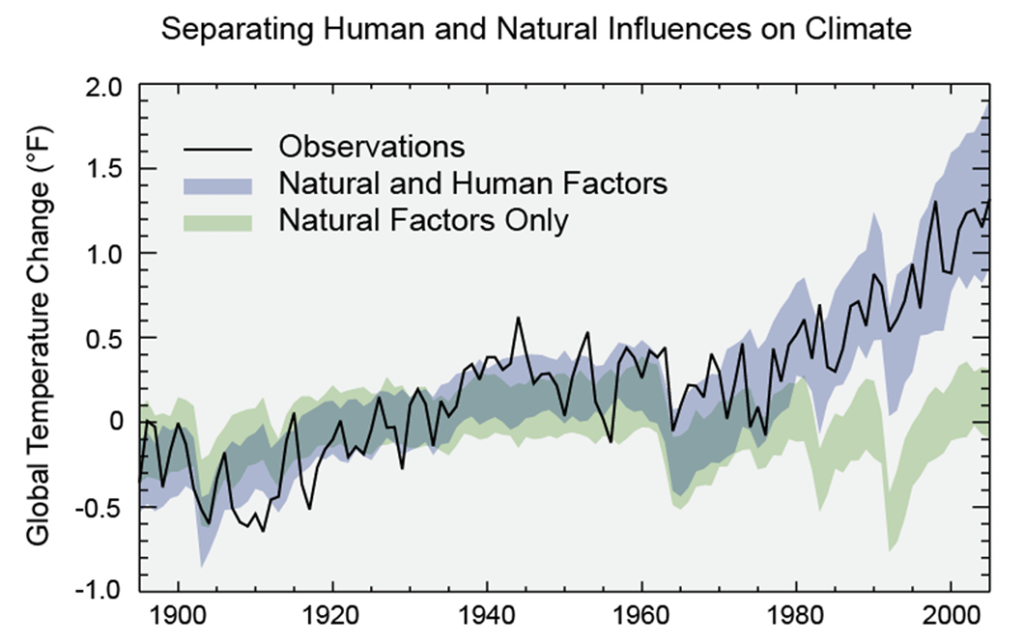Climate change is typically discussed as a future issue that can be dealt with through incremental action. However, everyone across the globe is experiencing the effects of climate change now and will continue to experience increasing impacts for generations to come. as such, governments at the national level down through the local need to take significant actions to respond to both the effects of and contributions to climate change.
Climate change refers to “long-term shifts in temperatures and weather patterns” that, while linked to natural variations like solar radiation or volcanic activity, has accelerated at unprecedented rates since the 1800s primarily, and almost exclusively, caused by the burning of fossil fuels like coal, oil, and gas.
‘Climate’ is different than ‘weather,’ which describes what is happening in the atmosphere at a specific time or on a day-to-day scale. Climate describes the average weather over time, meaning that climate change and weather are interlinked. One common mistake people make is considering unusually cold weather as ‘evidence’ against climate change. Our variable weather always delivers extremes of hot and cold. The frequency and intensity of individual weather events is changing as the climate changes. But when weather is averaged over space and time, the fact that the globe is warming emerges clearly from the data.
The increase in greenhouse gases (GHG) from fossil fuel burning and other human interventions (e.g., deforestation, intensive agriculture etc.) has led to changes in the atmosphere that have trapped more heat than in the past and is resulting in global temperature rises as well as extraordinary changes to climatic systems and planetary Combined land and ocean temperature has increased at an average rate of 0.06°C per decade since 1850, or more than 1.1°C in total, with the rate of warming expected to increase from 2020 onwards. Australia has already experienced more than 1.4°C of warming since 1910.
While significant global progress has been made to mitigate emissions to reduce the potential scope of climate change, total GHG emissions have continued to rise over the last decade. As a result, extreme weather events, also known as natural hazards, are increasing in frequency and intensity across the globe, forcing governments at all scales to respond and adapt. In Australia, it is recognised by all tiers of government that it is appropriate and effective to manage climate change at a ‘local’ scale. Yet, the Australian Government recognises that local governments will be key actors in adapting to the local impacts of climate change and their engagement will be a critical part of any national reform agenda.
The Greenhouse Gas Effect and Natural Variation
Climate change is driven by the acceleration of the Earth’s Greenhouse Effect. Greenhouse gases such as carbon dioxide (CO2), methane (CH4), nitrous oxide (N2O), and water vapour (H2O) naturally trap heat within the atmosphere, acting as a vital blanket that sustains life on Earth. However, since the onset of industrialization and the increased burning of fossil fuels, the concentration of these atmospheric gases, especially CO2 and CH4, has risen dramatically.
While naturally occurring greenhouse gas concentrations fluctuate over time, current levels are significantly higher than at any point in the last 800,000 years. Before the Industrial Revolution began around 1760, CO2 levels in Earth’s atmosphere averaged about 280 parts per million (ppm). Scientists have determined this through the analysis of air bubbles trapped in ice cores. As of May 2022, CO2 levels in Tasmania were measured at 414 ppm and continue to rise.
The current elevated levels of heat-trapping CO2 in the Earth’s atmosphere are a result of human activities, not natural processes. This is evidenced by the sharp increase in CO2 concentrations coinciding with the heightened anthropogenic burning of fossil fuels. No other physical processes can account for these elevated levels of greenhouse gases.
Observed global temperature changes closely align with models incorporating both natural and human factors, significantly diverging from those considering only natural factors. This stark contrast indicates that human influence, rather than natural variation, is the primary driver of recent climate change.


